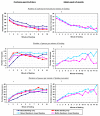Mechanics of sucking: comparison between bottle feeding and breastfeeding
- PMID: 20149217
- PMCID: PMC2837866
- DOI: 10.1186/1471-2431-10-6
Mechanics of sucking: comparison between bottle feeding and breastfeeding
Abstract
Background: There is very little evidence of the similarity of the mechanics of maternal and bottle feeding. We assessed the mechanics of sucking in exclusive breastfeeding, exclusive bottle feeding, and mixed feeding. The hypothesis established was that physiological pattern for suckling movements differ depending on the type of feeding. According to this hypothesis, babies with breastfeeding have suckling movements at the breast that are different from the movements of suckling a teat of babies fed with bottle. Children with mixed feeding mix both types of suckling movements.
Methods: Cross-sectional study of infants aged 21-28 days with only maternal feeding or bottle feeding (234 mother-infant pairs), and a randomized open cross-over field trial in newborns aged 21-28 days and babies aged 3-5 months with mixed feeding (125 mother-infant pairs). Primary outcome measures were sucks and pauses.
Results: Infants aged 21-28 days exclusively bottle-fed showed fewer sucks and the same number of pauses but of longer duration compared to breastfeeding. In mixed feeding, bottle feeding compared to breastfeeding showed the same number of sucks but fewer and shorter pauses, both at 21-28 days and at 3-5 months. The mean number of breastfeedings in a day (in the mixed feed group) was 5.83 +/- 1.93 at 21-28 days and 4.42 +/- 1.67 at 3-5 months. In the equivalence analysis of the mixed feed group, the 95% confidence interval for bottle feeding/breastfeeding ratio laid outside the range of equivalence, indicating 5.9-8.7% fewer suction movements, and fewer pauses, and shorter duration of them in bottle feeding compared with breastfeeding.
Conclusions: The mechanics of sucking in mixed feeding lay outside the range of equivalence comparing bottle feeding with breastfeeding, although differences were small. Children with mixed feeding would mix both types of sucking movements (breastfeeding and bottle feeding) during the learning stage and adopt their own pattern.
Figures
References
-
- Weber F, Woolridge MW, Baum JD. An ultrasonographic study of the organisation of sucking and swallowing by newborn infants. Dev Med Child Neurol. 1986;28:19–24. - PubMed
-
- Nowak AJ, Smith WL, Erenberg A. Imaging evaluation of artificial nipples during bottle feeding. Arch Pediatr Adolesc Med. 1994;48:40–42. - PubMed
-
- Medoff-Cooper B, McGrath JM, Shults J. Feeding patterns of full-term and preterm infants at forty weeks postconceptional age. J Dev Behav Pediatr. 2002;23:231–236. - PubMed


